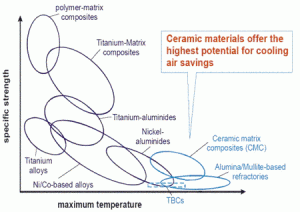15. Present Day Industrial Applications
| 1847 Page: 371 of 418 Go To Page: | ◁◁ First | ◁ Previous | Next ▷ | Last ▷▷ |
General cermet applications are for hip joints, dentistry, body armour and even fishing line rings. They are also used for brake discs and linings; needing both wear resistance and thermal conductivity to remove the heat, and clutch plates that last four times longer than alternatives. Other composites also used for friction brake discs and linings are made of carbon fibre reinforced ceramics such as silicon carbide. This material can withstand over 2000 ºC and is 70% lighter than cast iron. It is used on high performance cars, high-speed trains and aircraft as well as for components in rocket propulsion systems.
Similarly the “ceramer” is a mixture of ceramic and polymer that is flexible at room temperature but at high temperatures decomposes and the ceramic-like qualities take over. It has potential as a coating for wires used in high temperature jet engines.
Industrial applications of ceramics are widespread, therefore to illustrate them a more detailed description of a selection of applications is given below.
15.5 Structural Ceramics
When designing and erecting a large “industrial” building, a major consideration is the mechanical properties of the building materials. Mechanical properties describe the way that a material responds to forces, loads and impacts. Ceramics are strong, hard materials that are resistant to corrosion, have low densities, high melting temperatures (are fire resistant), which makes them attractive for structural applications. The major advantage of these products, including building bricks and tiles, is that they require no maintenance such as routine painting, and are relatively cheap. Bricks can be weather resistant for decades, although higher quality bricks are used for applications where they may be frozen when saturated with water, such as for foundations and retaining walls. As you might expect the market for bricks is immense, with the predicted production of over 8 billion bricks produced in USA alone in 2014, worth some $5Bn. As well as bricks, other uses of structural ceramics are roof tiles, chimney pots and liners, paviors, glazed tiles and sewer and water pipes. Major buildings were made wholly from bricks, particularly in the 19th century, when railways and canals were being widely constructed. Spectacular viaducts were constructed for the railways in Victorian times.

Brick viaducts, Whitby Larpool, Dollis Brook
and Lullingstone Kent - sources dunwurking,
britishblogs and Nigel Chadwick
Vast mills with associated chimneys are also reminders of the time when bricks were the main basis of industrial buildings before concrete and steel were introduced. Industrially it is more likely that bricks are used now for facing buildings rather than the main structural element.
Clay suitable for these wares is usually obtained reasonably locally, as the specification often is not too high. Facing bricks are made less porous (5-20%) so are fired higher to be more vitreous, and are sometimes salt-glazed. Pipes need rather more plastic clay than bricks and tiles, so they can be extruded. Typically the composition is 75-80% plastic buff clay and 15-25% grog, the latter reduces shrinkage and warping during drying and firing. To produce pipes, the clay is extruded by pressing through dies using an auger and they are then cut into appropriate lengths. They are carefully dried to prevent cracking and fired around 1100 ºC to achieve the required degree of vitrification. Paviors need to be structurally stronger than common bricks so they can support vehicular traffic, so they are also fired higher to achieve a higher vitrification. Firing is carried out in tunnel kilns 100m long.
There are, perhaps surprisingly, higher technologies also involved in structural ceramics. One example is the recent development in road surfacing by adding photocatalytic titanium dioxide to the concrete mix. This absorbs gaseous oxides of nitrogen converting them to soluble nitrates, thus contributing to the reduction of greenhouse gases. Such catalytic concrete has also been used on buildings, as it is also self-cleaning.



